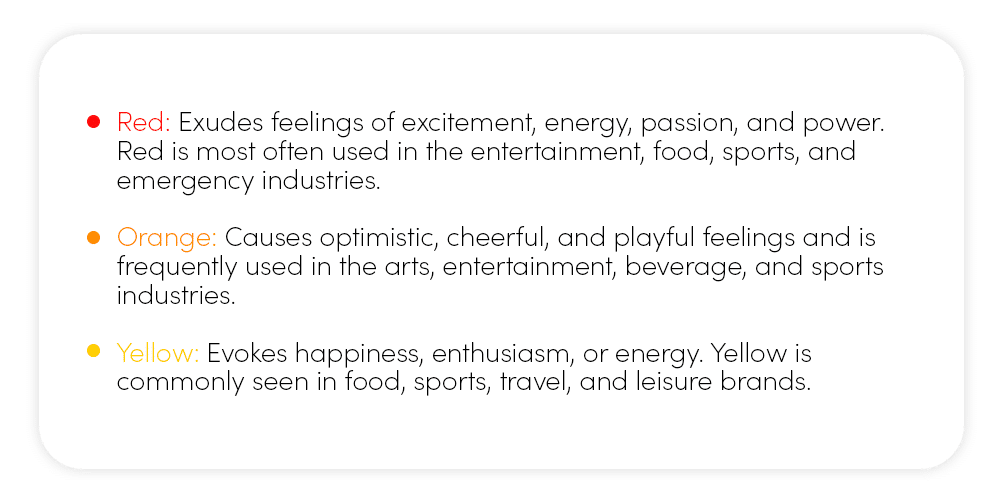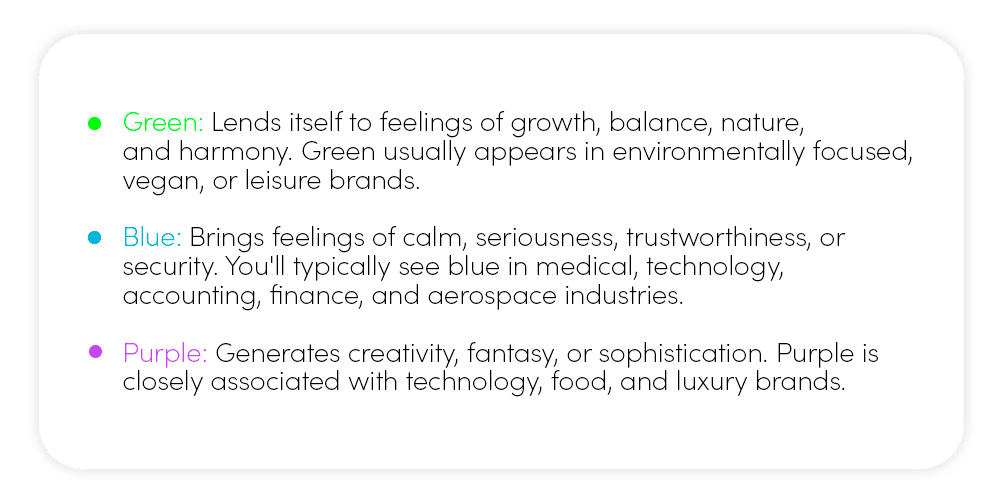Color psychology is an intriguing facet of modern marketing. Its far-reaching power of influence has been proven through multiple studies. Exhibit A: Did you know that Skittles actually don’t come in five flavors? Only their colors and scent profiles are different!
The top-selling companies have figured out how to harness this impact of color on branding, turning the science-based study of color psychology into a method of drawing consumers in. But what exactly is the psychology of color, how does it impact consumers, and how can brands harness it to influence growth? Let’s find out.
What Is Color Psychology?
Bright, warm colors make us feel happy or optimistic, and muted tones bring an atmosphere of calm. Yellow is synonymous with joy, blue is peaceful, and red is passionate and powerful. Most of us have a basic awareness of color psychology in marketing. Just consider how many medical organizations use strong blue hues in their logos, or the number of plant-based health brands that incorporate shades of green. Humans have intrinsic perceptions of color, and those perceptions heavily influence their purchasing decisions.
Colors can cause consumers to view your brand as trendy or modest, exciting or grounded, innovative or traditional. Understanding consumer perceptions well enough to create effective brand color strategy is a complex process, but it’s vital to a brand’s success. If you’re here today to learn how to use color psychology in marketing to create a strong brand identity, (matter) has the in-depth analysis you need.
Understand the Function of Colors
Color psychology in marketing states that certain colors evoke specific feelings and actions. Taking what you’ve learned about your brand’s identity and your competitor’s choices, let’s explore how different colors make consumers feel and which industries they’re most closely associated with to help you choose your own color palette.


The list goes on and on: You could incorporate pink into a logo to evoke hope, brown to convey a more serious attitude, or black to inspire efficiency and elegance. Interestingly, the most commonly used color in a company logo is blue, with red, gray, black, and silver following close behind.
The Impact of Color on Branding
Color psychology might seem like a niche area of study, but it’s backed by years of scientific research. In fact, studies have proven that color can influence up to 85% of consumers’ purchasing decisions. Once you understand just how deeply your target audience is influenced by something as simple as the shade of purple you use in your logo, you’ll open up an entire world of possibilities.
Many of today’s top businesses actually invest a large portion of their marketing budget into focus groups and market testing to uncover the impact of their color choices. This research applies to their logos, packaging designs, marketing materials, and more. Testing can give you insight into consumer sentiment about your brand color before you go public with your choices.
Curious about which companies are making color psychology, research, and testing work to their advantage? Here’s a quick rundown of some of the world’s most affluent businesses and the colors they use to draw customers in:
- McDonald’s – Those golden arches are no accident. Yellow, as we discussed above, signifies joy and happiness, while the red “McDonald’s” lettering below the arches stimulates the appetite. Together, this yellow and red logo is warm, inviting, and makes customers feel welcomed into the restaurant.
- Starbucks – The worldwide coffee chain became a household name with its green and white siren logo. Curiously enough, the siren’s green color not only connects the idea of coffee with growth and balance, but she also represents mystique, obsession, and addiction – feelings that many Starbucks fans have experienced!
- Mercedes-Benz – The luxury automaker with instant road recognition, Mercedes-Benz uses its clean silver logo to portray a classic, mature, and sophisticated personality and offers drivers the chance to share in those feelings by purchasing a high-end car or SUV.
Developing Your Brand Color Strategy
Making your color choices for brand identity can actually be a fun process, if you know how to start. To get the ball rolling, we’ve developed a four-step guide to help.

Reflect On Brand Identity
Before diving headfirst into choosing brand colors, make sure to reflect on your brand identity. Revisit those foundational aspects of your brand’s vision, goals, and voice to form a comprehensive picture of exactly what your brand stands for and the type of reputation it would like to build or maintain.
Need a quick tutorial on brand identity? Ask yourself the following questions
- What is your brand’s personality?
- How would you like customers to perceive your products or services?
- Does your brand stand for certain values, like sustainability or innovation?

Identify Competitors’ Colors
After you’ve reflected on your brand’s personal values, ask yourself what colors your competitors are using. The goal here isn’t to follow along with stereotypical associations or copy others in your industry; it’s to identify how you might differentiate yourself. Start with research: Are all your competitors using red? You might want to consider an opposing color to help your brand stand out.

Select & Expand Your Palette
After you’ve reflected on your brand’s personal values, ask yourself what colors your competitors are using. The goal here isn’t to follow along with stereotypical associations or copy others in your industry; it’s to identify how you might differentiate yourself. Start with research: Are all your competitors using red? You might want to consider an opposing color to help your brand stand out.

Focus Test Your Colors
Finally, don’t forget to test! From in-depth focus groups to simple digital surveys, investing in research can tell you about the effect of your color choices on consumers long before an expensive brand or product launch. Spending a little money on testing now can save you a large amount of your budget in the future!
Raise Your Color Game with the Experts at (matter)
Developing a brand color strategy can feel overwhelming, but the design experts at (matter) have decades of experience helping brands across all industries do just that, and at an extremely high level.
Our dedicated team partners with brands of all sizes and industries, from beer and macarons to prosthetics and medical technologies. We dive deep into their brand identities, uncover consumer and competitor data, develop crucial insights, and test our choices to give our clients the most effective strategies possible.
If you’re ready to integrate a brand color strategy that can light your brand impact on fire, take a stroll through the (matter) portfolio to see how our unique, data-based approach to color psychology in marketing elevates brands like Hydrotech, Mynd Gum, Louisville Slugger, and Mentos – and how your brand could join that roster.
